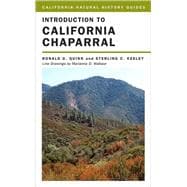
What is included with this book?
| Preface | p. xi |
| Acknowledgments | p. xiii |
| The California Chaparral | p. 1 |
| Fire and Chaparral | p. 7 |
| Where Is Chaparral Found? | p. 10 |
| Chaparral Is Found with Other Vegetation Types | p. 11 |
| Coastal Sage Scrub Is Not Chaparral | p. 16 |
| How Organisms Are Named | p. 17 |
| Mediterranean Climate | p. 21 |
| The Pacific High | p. 22 |
| Rainfall-Always Unpredictable | p. 23 |
| Winds That Carry Water or Take It Away | p. 26 |
| Temperature | p. 31 |
| Microclimates | p. 32 |
| Convergence | p. 35 |
| Rain Beetles Mate Only When There Is Rain | p. 39 |
| Fire | p. 43 |
| The Fire Cycle | p. 45 |
| The Fire Regime | p. 54 |
| Sources of Ignition | p. 61 |
| Aboriginal Burning | p. 62 |
| Nineteenth-Century Fire | p. 64 |
| Fire Patterns in the Twentieth Century | p. 66 |
| Modern Fires | p. 68 |
| Natural Responses of Plants and Animals to Fire | p. 70 |
| Plants | p. 75 |
| An Evergreen, Shrubby Vegetation | p. 77 |
| Common Shrubs and Shrub Families | p. 80 |
| The Rose Family (Roseaceae) | p. 81 |
| The Buckthorn Family (Rhamnaceae) | p. 90 |
| The Heath Family (Ericaceae) | p. 102 |
| The Oak Family (Fagaceae) | p. 114 |
| The Sumac Family (Anacardiaceae) | p. 120 |
| Other Chaparral Shrubs | p. 127 |
| Conifers: Cypresses, Pines, and Bigcone Douglas Fir | p. 132 |
| Common Herb and Subshrub Families | p. 135 |
| The Waterleaf Family (Hydrophyllaceae) | p. 137 |
| The Poppy Family (Papaveraceae) | p. 141 |
| The Lily Family (Liliaceae) | p. 145 |
| The Legume Family (Fabaceae) | p. 150 |
| The Snapdragon or Figwort Family (Scrophulariaceae) | p. 155 |
| Other Chaparral Herbs and Subshrubs | p. 161 |
| Introduced Weeds | p. 167 |
| Animals | p. 169 |
| Mammals | p. 172 |
| Rodents (Order Rodentia) | p. 172 |
| Rabbits and Hares (Order Lagomorpha) | p. 189 |
| Deer and Bighorn Sheep (Order Artiodactyla) | p. 190 |
| Carnivorous Mammals (Order Carnivora) | p. 194 |
| Birds | p. 201 |
| Perching Birds (Order Passeriformes) | p. 202 |
| Hawks (Order Falconiformes) | p. 212 |
| Owls (Order Strigiformes) | p. 215 |
| Reptiles | p. 215 |
| Snakes (Order Squamata, Suborder Serpentes) | p. 216 |
| Lizards (Order Squamata, Suborder Lacertilia) | p. 222 |
| Amphibians | p. 229 |
| Insects and Arachnids | p. 231 |
| Insects (Class Insecta) | p. 232 |
| Trap Door Spiders, Ticks, and Scorpions (Class Arachnida) | p. 243 |
| Other Chaparral Insects | p. 246 |
| Living with the Chaparral | p. 251 |
| Prescribed Fire | p. 254 |
| Fuel Reduction and Fuel Breaks | p. 258 |
| Artificial Seeding of Burns | p. 260 |
| Fire Creates Its Own Weather | p. 262 |
| Geographic Risk | p. 264 |
| Floods | p. 266 |
| Threats to Chaparral | p. 276 |
| Options for Wise Growth | p. 279 |
| The Value of Chaparral | p. 288 |
| Glossary | p. 293 |
| Supplemental Readings and References | p. 299 |
| Art Credits | p. 303 |
| Index | p. 305 |
| Table of Contents provided by Ingram. All Rights Reserved. |
The New copy of this book will include any supplemental materials advertised. Please check the title of the book to determine if it should include any access cards, study guides, lab manuals, CDs, etc.
The Used, Rental and eBook copies of this book are not guaranteed to include any supplemental materials. Typically, only the book itself is included. This is true even if the title states it includes any access cards, study guides, lab manuals, CDs, etc.